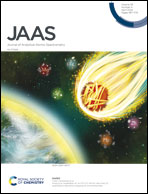Ultralow H2O content analysis with a large-geometry secondary ion mass spectrometer†
Abstract
Large-geometry secondary ion mass spectrometry (LG-SIMS) is routinely used to determine the elemental and isotopic compositions, thanks to its high sensitivity and in situ micro-analysis capability. Its large volumes of transfer and coupling column, however, might bring low vacuum and high background of volatile elements (esp. H), which hampers its application in ultralow H2O content measurement. In this study, we report a modified analytical procedure to accurately analyze samples with ultralow-level H2O content by using a LG-SIMS of type CAMECA IMS 1280-HR. Based on four new water content working reference materials of quartz glasses with H2O contents ranging from ca. 0 to 39 ppm, the estimated detection limit of LG-SIMS is 0.15 ppm for H2O. This ultralow detection limit is achieved mainly by the intrinsic high sensitivity of the instrument and the conjunctive usage of a stabilized temperature-controlled cooling trap device and a novel tin–bismuth alloy mount preparation technology, which are able to maintain a vacuum pressure at 1.7 × 10−9 mbar in the analysis chamber. Based on these new improvements, our approach can potentially become a routine choice for analyses of H2O content and oxygen–hydrogen isotopes for (extra)terrestrial materials with ultralow-level water content.



 Please wait while we load your content...
Please wait while we load your content...